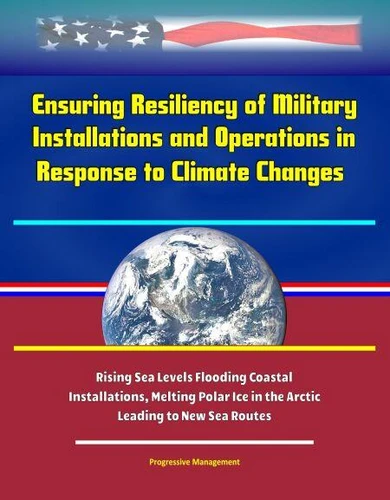Ensuring Resiliency of Military Installations and Operations in Response to Climate Changes - Rising Sea Levels Flooding Coastal Installations, Melting Polar Ice in the Arctic Leading to New Sea Route
Par :Formats :
Disponible dans votre compte client Decitre ou Furet du Nord dès validation de votre commande. Le format ePub est :
- Compatible avec une lecture sur My Vivlio (smartphone, tablette, ordinateur)
- Compatible avec une lecture sur liseuses Vivlio
- Pour les liseuses autres que Vivlio, vous devez utiliser le logiciel Adobe Digital Edition. Non compatible avec la lecture sur les liseuses Kindle, Remarkable et Sony
 , qui est-ce ?
, qui est-ce ?Notre partenaire de plateforme de lecture numérique où vous retrouverez l'ensemble de vos ebooks gratuitement
Pour en savoir plus sur nos ebooks, consultez notre aide en ligne ici
- FormatePub
- ISBN978-0-463-04751-4
- EAN9780463047514
- Date de parution17/03/2020
- Protection num.pas de protection
- Infos supplémentairesepub
- ÉditeurBluewater
Résumé
House of Representatives Committee on Armed Services hearing - The question before us: Is the U. S. military ready for climate change? Recent events indicate considerable doubt. Just this last year, Hurricanes Florence and Michael caused billions of dollars of damage to Camp Lejeune and leveled much of Tyndall Air Force Base in Florida. California wildfires led to the evacuation of family housing at Camp Pendleton, Naval Air Station Mugu, and the Marine Corps Mountain Warfare Training Center in the Sierras.
In addition, our coastal installations and the surrounding communities are already experiencing significant flooding due to sea-level rise. The Army's Ronald Reagan Ballistic Missile Defense Test Site at the Kwajalein Atoll in the South Pacific is threatened by sea-level rise and may not last 20 years. The Navy's principal Atlantic base, Norfolk-Hampton Roads, and the Naval Academy are already experiencing flooding.
Melting polar ice in the Arctic regions has already opened new sea routes and competition for resources. Yet it appears that the Department of Defense has not yet developed a systemic strategy for ensuring U. S. national interests in the Arctic. The United States military is one of the largest employers in the world. It is also one of the largest energy consumers. The DOD [Department of Defense] owns millions of acres of global real property, including over 550, 000 facilities valued at over a trillion dollars, and the Department is uniquely situated to enhance its readiness and resiliency through effective energy policy and programs.
Installations are where we generate the force, train and sustain them, and, in many cases, house critical operational missions. One way to enhance readiness is to consume less. In fiscal year 2017, the Department of Defense consumed over 85 million barrels of fuel to power ships, aircraft, combat vehicles, and bases. And it cost nearly $8.2 billion. In many cases, though, contract vehicles and energy-saving performance contracts-- these energy savings and resiliency-enhancement improvements can be made at no upfront cost to the Department.
This compilation includes a reproduction of the 2019 Worldwide Threat Assessment of the U. S. Intelligence Community.
In addition, our coastal installations and the surrounding communities are already experiencing significant flooding due to sea-level rise. The Army's Ronald Reagan Ballistic Missile Defense Test Site at the Kwajalein Atoll in the South Pacific is threatened by sea-level rise and may not last 20 years. The Navy's principal Atlantic base, Norfolk-Hampton Roads, and the Naval Academy are already experiencing flooding.
Melting polar ice in the Arctic regions has already opened new sea routes and competition for resources. Yet it appears that the Department of Defense has not yet developed a systemic strategy for ensuring U. S. national interests in the Arctic. The United States military is one of the largest employers in the world. It is also one of the largest energy consumers. The DOD [Department of Defense] owns millions of acres of global real property, including over 550, 000 facilities valued at over a trillion dollars, and the Department is uniquely situated to enhance its readiness and resiliency through effective energy policy and programs.
Installations are where we generate the force, train and sustain them, and, in many cases, house critical operational missions. One way to enhance readiness is to consume less. In fiscal year 2017, the Department of Defense consumed over 85 million barrels of fuel to power ships, aircraft, combat vehicles, and bases. And it cost nearly $8.2 billion. In many cases, though, contract vehicles and energy-saving performance contracts-- these energy savings and resiliency-enhancement improvements can be made at no upfront cost to the Department.
This compilation includes a reproduction of the 2019 Worldwide Threat Assessment of the U. S. Intelligence Community.
House of Representatives Committee on Armed Services hearing - The question before us: Is the U. S. military ready for climate change? Recent events indicate considerable doubt. Just this last year, Hurricanes Florence and Michael caused billions of dollars of damage to Camp Lejeune and leveled much of Tyndall Air Force Base in Florida. California wildfires led to the evacuation of family housing at Camp Pendleton, Naval Air Station Mugu, and the Marine Corps Mountain Warfare Training Center in the Sierras.
In addition, our coastal installations and the surrounding communities are already experiencing significant flooding due to sea-level rise. The Army's Ronald Reagan Ballistic Missile Defense Test Site at the Kwajalein Atoll in the South Pacific is threatened by sea-level rise and may not last 20 years. The Navy's principal Atlantic base, Norfolk-Hampton Roads, and the Naval Academy are already experiencing flooding.
Melting polar ice in the Arctic regions has already opened new sea routes and competition for resources. Yet it appears that the Department of Defense has not yet developed a systemic strategy for ensuring U. S. national interests in the Arctic. The United States military is one of the largest employers in the world. It is also one of the largest energy consumers. The DOD [Department of Defense] owns millions of acres of global real property, including over 550, 000 facilities valued at over a trillion dollars, and the Department is uniquely situated to enhance its readiness and resiliency through effective energy policy and programs.
Installations are where we generate the force, train and sustain them, and, in many cases, house critical operational missions. One way to enhance readiness is to consume less. In fiscal year 2017, the Department of Defense consumed over 85 million barrels of fuel to power ships, aircraft, combat vehicles, and bases. And it cost nearly $8.2 billion. In many cases, though, contract vehicles and energy-saving performance contracts-- these energy savings and resiliency-enhancement improvements can be made at no upfront cost to the Department.
This compilation includes a reproduction of the 2019 Worldwide Threat Assessment of the U. S. Intelligence Community.
In addition, our coastal installations and the surrounding communities are already experiencing significant flooding due to sea-level rise. The Army's Ronald Reagan Ballistic Missile Defense Test Site at the Kwajalein Atoll in the South Pacific is threatened by sea-level rise and may not last 20 years. The Navy's principal Atlantic base, Norfolk-Hampton Roads, and the Naval Academy are already experiencing flooding.
Melting polar ice in the Arctic regions has already opened new sea routes and competition for resources. Yet it appears that the Department of Defense has not yet developed a systemic strategy for ensuring U. S. national interests in the Arctic. The United States military is one of the largest employers in the world. It is also one of the largest energy consumers. The DOD [Department of Defense] owns millions of acres of global real property, including over 550, 000 facilities valued at over a trillion dollars, and the Department is uniquely situated to enhance its readiness and resiliency through effective energy policy and programs.
Installations are where we generate the force, train and sustain them, and, in many cases, house critical operational missions. One way to enhance readiness is to consume less. In fiscal year 2017, the Department of Defense consumed over 85 million barrels of fuel to power ships, aircraft, combat vehicles, and bases. And it cost nearly $8.2 billion. In many cases, though, contract vehicles and energy-saving performance contracts-- these energy savings and resiliency-enhancement improvements can be made at no upfront cost to the Department.
This compilation includes a reproduction of the 2019 Worldwide Threat Assessment of the U. S. Intelligence Community.























